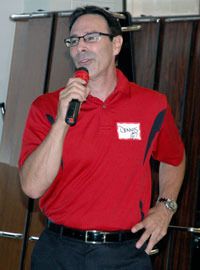LAKEWOOD — The good news from the Monday, Aug. 26, public meeting at Lakewood High School was that the main high school building could be fully renovated, and new classrooms could be added to replace its aging secondary buildings and portables, without raising the current tax rates for homeowners living within the Lakewood School District.
The news that even the most positive of meeting attendees admitted would be a tough sell is that the district’s Educational Specification Committee has recommended additional renovations for Lakewood High School that would increase local homeowners’ taxes by $14.22 per month from the 2013 rates, based on a property with $250,000 of assessed value.
According to Lakewood School District Superintendent Dr. Dennis Haddock, even with site work to improve the high school campus’ traffic, parking and utilities, plus field and tennis court upgrades, a new bond would cost $59.8 million, which would be reduced to $53.4 million with state funding assistance, thereby yielding no tax increase for homeowners.
However, if the bond were to include all five of the additional projects proposed by the Ed Spec Committee — additional space for new educational programs, collaborative learning areas, an auxiliary gymnasium, synthetic turf for soccer, track and field, and both competition and practice fields for softball and baseball — the price tag would shoot up to $77.8 million, which would still be $71.4 million even with state construction assistance.
When Haddock asked attendees of the Aug. 26 public meeting to work in small groups to rate those five additional projects in terms of how important those survey respondents considered them to be, many spokespersons for their groups deemed all five additional projects to be equally essential to the bond, albeit interspersed with a few voices of relative caution.
“As we’re preparing our students for college careers, we need to offer them everything we can now,” Lars Espeland said. “An extra $171 a year in taxes is well worth it.”
“If we don’t ask for it now, we probably won’t be able to ask for it later,” Peggy Webb said. “We need everything on this list, so we have to try to sell it to the community. We want our students to want to go to Lakewood High School.”
“You’ve got to get the community to say yes,” Katy Trapp said. “If their taxes are going up by $9.99 a month or less, then that’s a cup of coffee, but if it’s nearly $15 a month, that feels too much like an extra bill.”
“I worked on the last levy committee, and it passed by 58 percent,” Barbara Farrand said. “This would require a 60 percent majority to pass, and if there’s too much in this package, it won’t pass because a lot of retirees in this district won’t see what you see in these projects.”
A number of attendees proposed cost mitigations of their own. While district officials explained that Alisa Roebke’s suggestion of extending the bond repayment timeline would result in a greater cost in the long run due to interest rates, they agreed that Sally Newman’s proposed green energy measures would save money in the long run, but unfortunately add to the bond’s initial price tag. When Todd Duitsman inquired about soliciting corporate endorsements, and Larry Delaney asked the same about partnering with the local cities or Native American tribes, Haddock didn’t rule out those ideas.
Haddock promised that the Lakewood School District would solicit further public input during their ice cream socials and open houses at the English Crossing and Cougar Creek elementary schools on Thursday, Aug. 29, at Lakewood High School on Wednesday, Sept. 11, and at Lakewood Middle School on Tuesday, Sept. 17.



